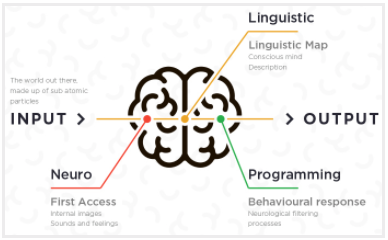NLP stands for Neuro-Linguistic Programming. You may have never heard of it, but it’s time you learn about the process and how you can apply NLP in sales.
Background
It was originated and developed by John Grinder and Richard Bandler in 1975. Grinder had a background in linguistics and Bandler had a background in mathematics and gestalt therapy. They developed this for the purpose of making explicit models of human excellence.
In their first work, The Structure of Magic Volumes I & II, they identified the verbal and behavioral patterns of therapists Fritz Perls, who was the creator of gestalt therapy, and Virginia Satir, an internationally renowned family therapist.
Their following work, Patterns of the Hypnotic Techniques of Milton H. Erickson, M.D. Volumes I & II, chronicled the verbal and behavioral patterns of Milton Erickson. As the founder of the American Society of Clinical Hypnosis, Erickson is one of the most widely acknowledged and clinically successful psychiatrists of our time.
The 3 Most Influential Components
Neuro-Linguistic Programming is a powerful sales psychology that is composed of the three most influential components involved in producing a human experience:
- Neurology: controls and regulates how our body functions
- Language: determines how we interact and communicate with other people
- Programming: determines the types of models we create in the world and how we view certain things

Encompassing all of this together, Neuro-Linguistic Programming describes the fundamental essentials between the mind, our language, and how this combination affects our body and behavior.
The reason NLP is so important in your sales pitch is because it involves the development of behavioral competence and flexibility. At the same time, it also involves strategic thinking and an understanding of the mental and cognitive processes behind behavior.
Neuro-Linguistic Programming gives us the tools and the skill set to develop states of individual excellence, while also establishing a system of empowering beliefs and presuppositions about what human beings are, what communication is and what the process of change is all about. Remember that sales is all about communication. It’s about how you can move one person from their thinking to align with your own.
NLP plays a large part in self-discovery and exploring your own identity. When you’re able to understand your own self, you can begin to understand others, especially for the purpose of aligning their thoughts and beliefs with your own.
Neuro-Linguistic Programming will help you in your sales pitch because it largely pertains to wisdom and vision. This is critical in knowing how and where to take a conversation when you have a potential customer who doesn’t align with your vision from the start.
Two Fundamental Principles of NLP:
- The map is not the territory
- Life and mind are systematic processes
The scholars of NLP believe it was founded on these two fundamental presuppositions. What they’re saying is that as humans, we never actually know reality. Instead, what we actually know are our perceptions of reality. We experience and respond to the life experiences we have which shape our version of the truth in our mind.
It’s our neuro-linguistic maps of reality that determine how we behave and that give those behaviors meaning compared to reality. The processes that take place within us and our environment are systematic. Everything from our bodies to our societies form and ecology of complex systems and subsystems, all of which interact with and mutually influence one another.
All of the models and techniques of NLP are based on the combination of these two principles.
Simplifying NLP
Have you ever tried to talk to someone who didn’t speak the same language as you and, as a result, couldn’t understand you?
The most basic example of this is when you go out to a restaurant in a foreign country and think you’re ordering a nice, juicy steak, but when the food arrives you’re shocked to see what you really ordered was liver.
This is the type of relationship that most of us experience within our own unconscious mind. We think and believe we’re “ordering up” more money and a happier, healthier life, but unless that’s what is showing up, something is most likely getting lost in translation.
NLP is like a user manual for the brain and learning how to become fluent in the language of the mind.
Using NLP In Sales
Understanding NLP is one thing, but translating this into your sales pitch when speaking with a potential customer is completely different. The strategies below are Richard Bandler’s recommendations for incorporating Neuro-Linguistic Programming into your sales pitch.
- Be aware of your body language and others
- Pay attention to your intonation and others
- Focus on verbiage and grammar use
- Build rapport
- Pacing and leading
- Be aware of your emotional state and how to keep hold of that state
Body Language
Your body language can cost you a sale without you even realizing it. You have only 7 seconds to make a good first impression that will establish credibility, trust, status and empathy.
During face to face meetings, 93% of people’s judgment of others are based on non-verbal inputs like body language. And these stats are based on personal meetings altogether. Throw in the sales aspect of it and you can easily see how important it is.
55% of the effectiveness of your communication comes from sales body language, 38% from the tone of your voice, and only 7% from what you actually say. Check out the 5 body language mistakes that could cost you the sale.
Intonation
Intonation is the rise and fall of your voice when speaking; it’s essentially your tone. Have you ever noticed yourself copying a friend or family member, or them copying you? No, not copying your school work, but the terminology you use or the way you speak. You may not even know you’re doing it, but you can close more sales by using the right tone.
We instinctively copy other people, especially those closest to us. This is actually a sales psychology called mirroring, sometimes also referred to as matching. When you mirror someone you’re adopting their physical and verbal behaviors.
This doesn’t mean you should try to be exactly like that person. The key to this strategy is to be subtle with it and go unnoticed.
Several studies have found that mirroring or matching someone consciously helps salespeople to move others easier and sell more. Your ultimate goal is not to make someone believe something they don’t, but to move them to your way of thinking.
Mirroring happens when you match the mannerisms or characteristics of the person you’re speaking with.
_____
SPOTIO is the #1 field sales engagement and performance management software that will increase revenue, maximize profitability, and boost sales productivity.
Want to see a product demonstration? Click here to see how SPOTIO can take your sales game to the next level.




